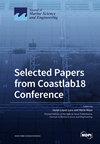Modeling the Impacts of Land Reclamation on Sediment Dynamics in a Semi-Enclosed Bay
IF 2.8
3区 地球科学
Q1 ENGINEERING, MARINE
引用次数: 0
Abstract
Semi-enclosed bays are significantly influenced by the interactions between land and sea, as well as human activities. One notable human activity, land reclamation, impacts water exchange within these bays. However, the variability of sediment transport and cross-bay transport following reclamation remains poorly understood. This study aims to enhance the understanding of sediment dynamics and the responses of cross-bay transport to reclamation. A well-validated three-dimensional numerical model was developed in the Laizhou Bay (LB). Following reclamation, tidal currents suspended sediment concentration, and erosion increased seaward, while these factors decreased landward. In LB, surface and bottom subtidal currents flowed in opposite directions, with the direction of volume transport primarily determined by bottom currents. In the western LB, volume and sediment transport exhibited an anticyclonic pattern, with pronounced seasonal variations observed elsewhere. During summer, volume and sediment transport predominantly occurred from the northeast to the southwest. In winter, volume transport in northern LB was directed westward, while it was eastward in the southern part; sediment transport was primarily eastward. Advection played a significant role in sediment transport dynamics. The pathway of cross-bay sediment transport was primarily located in the central part of the bay. Notably, the cross-bay sediment transport flux in winter was approximately 3.5 times greater than in summer, with reclamation resulting in a reduction in cross-bay transport flux by about 22.17%.模拟土地开垦对半封闭海湾沉积动力学的影响
半封闭海湾受到陆地和海洋之间的相互作用以及人类活动的重大影响。填海造地这一显著的人类活动影响了这些海湾内的水体交换。然而,人们对填海后沉积物运移和跨海湾运移的变化仍然知之甚少。这项研究旨在加强对沉积物动力学和跨海湾输运对填海的反应的了解。在莱州湾(LB)建立了一个经过充分验证的三维数值模型。填海后,潮汐流悬浮泥沙浓度和侵蚀作用向海方向增加,而这些因素向陆方向减少。在莱州湾,表层潮汐流和底层潮汐流流向相反,体积运移方向主要由底层流决定。在浐灞西部,体积和沉积物运移呈现出反周期模式,其他地区则有明显的季节性变化。夏季,体积和沉积物迁移主要从东北方向流向西南方。冬季,浐灞北部的水量输送向西,而南部则向东;沉积物主要向东输送。平流在沉积物运移动力学中起着重要作用。跨海湾沉积物运移的路径主要位于海湾中部。值得注意的是,冬季的跨湾泥沙输运通量约为夏季的 3.5 倍,填海导致跨湾输运通量减少了约 22.17%。
本文章由计算机程序翻译,如有差异,请以英文原文为准。
求助全文
约1分钟内获得全文
求助全文
来源期刊

Journal of Marine Science and Engineering
Engineering-Ocean Engineering
CiteScore
4.40
自引率
20.70%
发文量
1640
审稿时长
18.09 days
期刊介绍:
Journal of Marine Science and Engineering (JMSE; ISSN 2077-1312) is an international, peer-reviewed open access journal which provides an advanced forum for studies related to marine science and engineering. It publishes reviews, research papers and communications. Our aim is to encourage scientists to publish their experimental and theoretical results in as much detail as possible. There is no restriction on the length of the papers. The full experimental details must be provided so that the results can be reproduced. Electronic files and software regarding the full details of the calculation or experimental procedure, if unable to be published in a normal way, can be deposited as supplementary electronic material.
 求助内容:
求助内容: 应助结果提醒方式:
应助结果提醒方式:


